Hi there. The following are the opinions and thoughts of a newbie when it comes to Designmatters and Designing for Equity and Inclusion, so tread lightly.
Just a couple weeks ago, the ArtCenter community had the privilege of sharing some really raw and important conversations with Dr. Sumi around our roles as designers in this world. I say we had the privilege with no pun intended, as the conversation did lead us to examining our own life privileges. However, I want to emphasize this one opinion of mine to anyone reading: Learning from life experts like Dr. Sumun Pendakur is a pretty remarkable thing that we shouldn’t take for granted. I learned more about myself in those two hours over zoom than I have in these past 7 months of isolation. And as far as what it brought to my design process? It’s made me confident in my decision to purse and even demand equitable and inclusive designs going forward. If you’re not familiar with the workshop Dr. Sumi held, I strongly urge you to contact Kimberly Velazco for the recording! And listen to it over a sandwich… or the time you would have spent on Instagram making sure your time-real makes it all the way back to the very last post you saw six hours ago. Or I’ll send it to you! Or just read this I guess.
Have you ever wondered if the work you’re doing actually means anything? Dr. Sumi provided us with some fantastic tools on how to finally start answering some of those nagging Sunday-night-thoughts. She set the conversation up so warmly with a literal breathe of fresh air that we all (I think we all) took to center ourselves. Perhaps zoom classes should regularly start this way because, I swear to you, these were two zoom hours among many where my back never hurt and my eyes didn’t feel like I’d been driving through a wind tunnel in a hood-less convertible. (dry). So grapple with me on this for a second. First, Dr. Sumi enlightened us on the gaps in all of our practices. Look at yourself, your life experiences, your upbringing, your network, and examine what parts of those built the way you think, create, and design. Knowing the biases, we may have in life, sometimes to no fault of our own, can give us so many opportunities to check those blind spots in our designs. She shared a quote I immediately copied onto a sticky note and pressed onto the side of my monitor:
“We don’t see things as they are, we see them as we are.”
-Anais Nin
I see the world as a Mexican/American, 2nd generation, Latina from a middle-class family, straight, atheist, and able-bodied woman. So I tend to design with mostly those life experiences in mind, and through that particular lens. Sometimes, unknowingly. So does my current body of work mean anything? Well, to whom? Where? When? Honestly, my most impactful work will probably come in the future, when I’ve gained more cultural humility and I’ve taken a lot of time to put it into practice. From now on, that’s how my time at ArtCenter will be spent. Designing for equity means to acknowledge that peoples’ histories and lived experiences and resources are different from mine. And designing with equity in mind is designing without problem enticing the people I choose to design for, or putting them in a deficit perspective. Dr. Sumi put it most eloquently by stating the difference between the “Golden Rule” and the “Platinum Rule”. One says to do onto others as you would want done onto you. But the other says to do onto others as they would like done onto them. (this is another thing I “sticky-noted”). It really resonated with me because in asking myself earlier if my work means anything, I wasn’t asking the right person. I can’t assume an answer for others. And that’s just it, my intent is to design for others. Maybe you’re already on track with this and you practice equitable and inclusive design regularly. Maybe you’re like me and you say you want to design in that manner but you still have a lot left to learn. Maybe you’re confused right now. So I’ll move on to the final question that the inspiring Dr. Sumi left us with. Just kidding, I’m leaving you with three questions she left us with. Here they are:
– What does it look like to create a world through our own actions in which we build a space where people can truly live in the fullness of their humanity?
– What equity-minded and anti-racist commitments will you make?
– How will your commitment show up through concrete actions?
I know we all may get a little annoyed when we get asked questions that we’re not even sure the people asking them have the answers to. So, I’ll make this blog even longer by giving you my thoughts on those three questions. Practice makes permanent. So, if I practice checking myself during every one of my design processes from here on out, and remind myself that the point of my sleepless nights aren’t to create a beautiful portfolio but rather to practice the work I so desperately hope to do professionally in the equitable and inclusive design world. And if my peers do the same. Maybe the next election won’t feel like the end of the world we were all expecting in 2012 but didn’t happen. Or maybe it will just make us all better humans and therefore better designers for humans.
Virtual hugs,
Ana-Paola Laveaga (Environmental Design, Student, 6th term)
